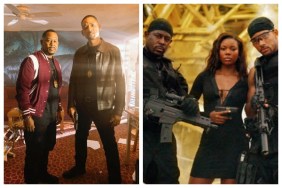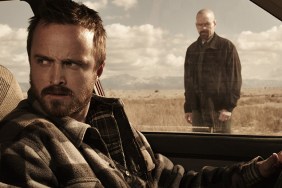
Strange things happen when movies come in threes. Either the plan for an entire franchise is finally revealed, or it becomes suddenly, crashingly clear that there was never any plan at all, as the series starts to fly off of the rails. That third movie in a franchise can be the make it or break it point, proving once and for all that the series has legs or that it has already run out of ideas.
These third films, sometimes called “threequels” (because isn’t that clever?), are practically a genre in and of themselves. Sometimes brilliant, usually strange, and sometimes completely overblown, they either mark a new beginning for any given series or signal the inevitable end. So here at CraveOnline we’ve tasked our critics – William Bibbiani, Witney Seibold and Brian Formo – to decide once and for all… What’s The Best Threequel Ever?
Find out what they picked, vote for your favorites at the bottom of the page, and come back later this week to find out how Taken 3 fares against the competition. It’s gotta be better than Taken 2, right? (Right?) And don’t forget to return every Wednesday for another thrilling installment of The Best Movie Ever!
Check Out: What’s The Best Tim Burton Movie Ever?
Brian Formo’s Pick: The Good, The Bad and the Ugly (1966)

Best standalone third movie in a series, huh? I actually think that that’d be Before Midnight. But as a standalone narrative, the power of Midnight wouldn’t be so powerful if we hadn’t already spent four hours in previous films hoping that that couple would be together through thick and thin. The “Three Colors Trilogy” ends on a great note with Red, but I am a bigger fan of the first film, Blue.
Related: The 50 Greatest Movie Franchises of All Time
Witney Seibold’s Pick: Three Colors: Red (1994)

The Law: Movie #1 is a success, and a sequel is then planned. Movie #2 ratchets up the drama and action, so that it plays like a bigger version of the first. It is also a success and a third movie is planned. Movie #3, however, is at a crossroads. Either it has to ratchet the drama and the action up even further – usually to a ridiculous degree – or it has to take the series “in a new direction,” introducing new characters or even altering the premise. Third movies – or “threequels,” to use the common yet decidedly unpoetic term – are often doomed from the beginning. This is why so many storytellers are fond of lumping films into “trilogies.” The final chapter can at least have the distinction of wrapping things up. So when a third film in a series is good, it’s something of a fluke; I can think of dozens of film series that have an awful, or at least mediocre, third chapter.
For a great film that comes third in a series of three, I select Krzysztof Kieślowski’s 1994 film Red, the final part in the celebrated Three Colors trilogy. The three colors allude to the colors of the French flag and their corresponding national characteristics. Blue = liberty, white = equality, and red = fraternity. Blue told the story of a widow learning to live with newfound liberty. White told the tale of a bad marriage and how a deliberately jilted husband gets revenge on his cheating wife… but in a romantic sort of way. Red is the most complex of the three, telling the tale of a French model (Irène Jacob) who discovers that her neighbor – a cynical judge played by Jean-Louis Trintignant – eavesdrops on his neighbors’ telephone calls. Why does he spy? Mostly just to feed his own isolation and misanthropy.
Slowly, however, we begin to see this odd dynamic as a way of exploring the way human beings relate to one another. Red is a film, ultimately, about how we are all lucky to relate to one another. It is, truly, a film about fraternity, and how our most human instincts will ultimately overwhelm the adolescent impulses of misanthropy and cynicism. It works as a standalone film, but also as a culmination of an impressive and ambitious cinematic project by a masterful filmmaker.
Related: All 92 ‘Step Up’ Dance Sequences, Ranked
William Bibbiani’s Pick: Step Up 3D (2010)

I am the first person to admit that one of these things is not like the other. But damn it, we’ve been running the Best Movie Ever column for over a year now, and in all those 52 installments, I hardly ever picked my favorite film in the category or genre. This one time – just this once – I’m going with my gut. I’m going to say that Step Up 3D is a better threequel than The Good, The Bad and the Ugly, Three Colors: Red, Toy Story 3, Before Midnight, The Return of the Jedi, The Return of the King, Die Hard with a Vengeance, Goldfinger and I really have lost my mind, haven’t I?
But it’s my mind and I’ll do what I want with it. Step Up 3D is pure glory. Like many threequels in a long-running franchise, this film isolates one the most popular aspects of the series – in this case, the dancing – and amplifies it beyond all reason. But whereas Spider-Man 3 took its comic book mythology so far it became ludicrous and hard to follow, and whereas Scream 3 took the inside baseball horror movie jokes so far it undermined the horror, the dancing is really the whole reason the Step Up franchise existed in the first place. The plot is goofy and simple – good dancers are good, bad dancers are bad, and everyone should totally dance – and director Jon M. Chu uses it as a delivery system for one incredible dance sequence after another.
And even when Step Up 3D goes completely insane, it does so in a charming, perfectly “threequel” sort of way. The movie begins with a Moose dance-fighting a samurai, joining a league of practically superpowered dancers (including a robot), and keeping his dance identity secret from his almost-but-not-quite girlfriend. Drizzle in some intrigue, parkour, masquerade balls, Olsen Twins cosplay, road warriors, neon fireflies, lasers and romantic floating Slurpees and you’ve got a film that goes deliciously over the top… but stays lovable. The characters are sincere and charming. The situations they find themselves in are thoroughly nuts. And by the end you’re cheering and begging for yet another movie in the Step Up series.
That makes it the best threequel ever, damn it. (Just let me have this one.)







